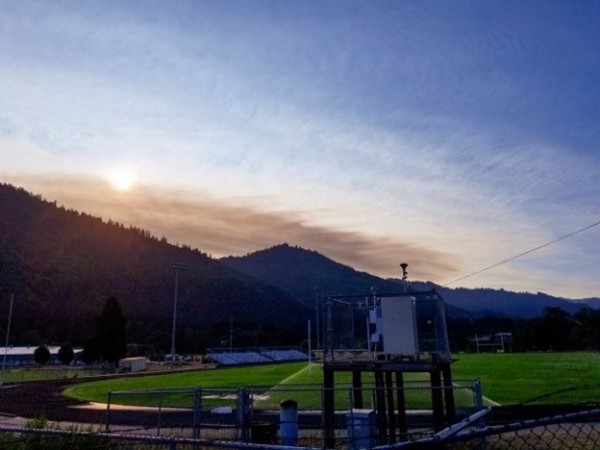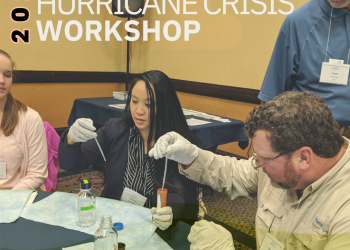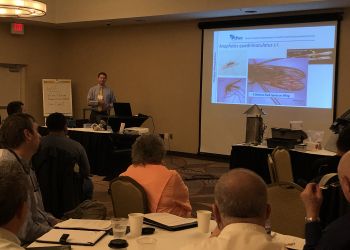This post was written by Ann Cornelius Brown, Science Communications Lead, EPA Office of Research and Development. Blog Image Description: Wildfire smoke obscures the sunrise from the Hoopa Air Monitoring Platform in 2020. Credit: Brian McCaughey.
The U.S. Environmental Protection Agency’s (EPA’s) researchers are working to provide the science needed to better prepare and respond to outdoor and indoor wildfire smoke. The science is part of a large federal initiative by the Biden-Harris Administration outlined in a White House fact sheet to address the growing threat from wildfires, which are increasing in size and intensity, driven in large part by climate change.
One multi-faceted study has brought together a large and diverse group of experts, including scientists, public health officials, building owners, and sensor technology innovators, to address community health impacts from wildfire smoke. The research includes field and laboratory studies, a prize-based challenge to encourage innovations in the development of indoor air cleaners, an air sensor loan program for air quality advisors, and collaborations with heating and air conditioning experts and a product safety testing organization.
“This research approach has been gratifying, as we are designing and quickly implementing studies to address time-sensitive questions about smoke episodes and how to protect the public when community members may have limited choices other than to stay indoors. This research will be impactful because of the input and support of our local partners.”
– Amara Holder, one of the EPA research engineers leading the project
For the field research, scientists are partnering with the Missoula City-County Health Department (MCCHD) in Montana, University of Montana, and the Hoopa Valley Tribe in California, two communities that are impacted by wildfire smoke. The objectives of the study, called Wildfire- Advancing Science Partnerships for Indoor Reductions of Smoke Exposures (ASPIRE) Study, are to develop new solutions and approaches for reducing wildfire smoke exposures. The ASPIRE study is part of EPA’s solutions-driven research initiative, which emphasizes working directly with stakeholders to develop solutions to public health and environmental concerns.
The research is focused on reducing exposure to fine particulate matter (PM2.5), a main component of smoke that can cause health problems at elevated levels, especially for those with lung or cardiovascular disease. To learn more about air quality during smoky conditions, scientists placed portable sensors outside and inside commercial and public buildings in Missoula and Hoopa. They then evaluated building characteristics and occupant practices that may affect indoor air pollution. Field studies have been completed in Missoula and will continue in Hoopa through 2021.
Scientists plan to share study results with the partners and building owners, including air monitoring trends and building evaluation summaries. The information is expected to help partners learn about smoke intrusion and actions that can be taken to reduce smoke indoors.
“The data from this field study will show the variability of indoor air quality in buildings across our community and will help us better understand how much outdoor air comes inside under real-world conditions. We expect the results will help us provide our community with practical advice about creating cleaner air spaces during wildfire smoke events.”
– Sarah Coefield, air quality specialist with MCCHD
“This important research has helped the Hoopa Valley Tribe improve our understanding of the different drivers of indoor concentrations during wildfire smoke events, including door and window opening, air handling system operation, use of portable air cleaners, and filter maintenance status.”
– Brian McCaughey, air resources specialist with the Tribe
The ASPIRE study’s complementary components to address indoor and outdoor air quality during wildfires are:
- Laboratory Studies: Studies are being conducted at EPA laboratories in Research Triangle Park, North Carolina, to evaluate the effectiveness of commercial and do-it-yourself (DIY) portable air cleaners to control smoke inside homes and buildings. EPA is also partnering with Chemical Insights Research Institute of Underwriters Laboratories Inc. (UL), which has tested the safety of the DIY air cleaners. The non-profit testing organization has published the report, Wildfire Safety Research: An Evaluation of DIY Air Filtration.
- Prized-based Challenge: To stimulate new and affordable technologies and approaches for indoor smoke exposure reduction, EPA partnered with several organizations to launch the Cleaner Indoor Air During Wildfire Smoke Challenge. This science-based challenged encourages development of new, effective, low-cost approaches to clean PM2.5 from indoor air, especially during wildfire smoke events or high pollution episodes. Winners of the challenge are expected to be announced this fall. In 2022, a second phase of the challenge is planned to encourage development of prototypes. Learn more about the Challenge.
- Wildfire Smoke Air Monitoring Response Technologies Pilot (WSMART): EPA is planning a pilot to loan portable air monitoring equipment to federal, state, local and tribal organizations involved in air monitoring during wildfires. The monitoring equipment will be provided to the Interagency Wildland Fire Air Quality Response Program for use by Air Resource Advisors to support Incident Management Teams at major wildfires, and to state, local and tribal air organizations in areas affected by wildfire smoke. The equipment includes two commercial sensors and a portable monitoring system developed by EPA researchers that can be used to obtain mobile measurements in a vehicle.
- ASPIRE-Health: EPA researchers, in partnership with the Hoopa Valley Tribe, are adding a new study component in 2021 called ASPIRE-Health. Researchers will test the effectiveness of two air cleaners (DIY and commercial) during smoke episodes in tribal households with no indoor smoking and assess potential improvements in air quality and health. Learn more about ASPIRE-Health.
- Commercial and School Building Guidance: EPA scientists and other federal and international organizations are serving on a committee organized by ASHRAE (formerly the American Society of Heating, Refrigerating and Air Conditioning Engineers) to develop guidelines for commercial buildings and schools to reduce smoke exposure for occupants. ASHRAE has released interim guidance that recommends heating, ventilation, and air conditioning (HVAC) and other building measures to minimize smoke intrusion during wildfires and prescribed burning. The guidance document is Planning Framework for Protecting Commercial Building Occupants from Smoke During Wildfire Events. A final document is expected to be completed in 2022.







